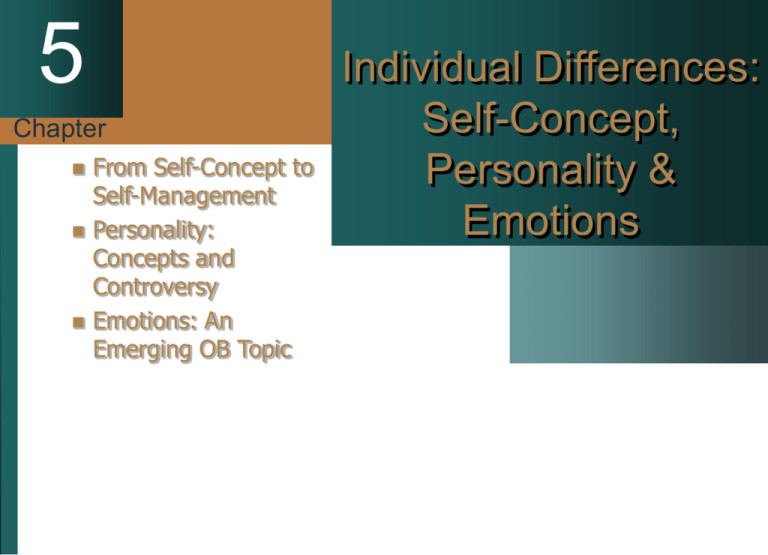
5
Chapter
From Self-Concept to
Self-Management
Personality:
Concepts and
Controversy
Emotions: An
Emerging OB Topic
Individual Differences:
Self-Concept,
Personality &
Emotions
Self-concept
Cognitions
held about oneself as a physical,
social, spiritual, or moral being
Self-esteem – one’s overall self-evaluation
Self-efficacy – belief about one’s chances
of successfully accomplishing a task
General
Specific
Self-fulfilling
prophecy
Research shows
Self-concept
Varies
by historical era, class, culture
Self-esteem – moderately related to life satisfaction
– negative self-view, trouble dealing with
others, self-doubt
High
Low
Self-efficacy
– learned helplessness
High - success
Low
5-7
Figure 5-2
Effects of High Self-Efficacy
Sources of Self-Efficacy
Beliefs
Feedback
Behavioral Patterns
Results
Be active—select best
Prior
Experience
opportunities
High
“I know I
can do this job”
Prior
Experience
Manage the situation—
avoid or neutralize
Success
obstacles
Set goals—establish
standards
Plan, prepare, practice
Prior
Experience
Self-efficacy
beliefs
Try hard: persevere
Creatively solve
problems
Learn from setbacks
Visualize success
Prior
Experience
McGraw-Hill
Limit Stress
© 2004 The McGraw-Hill Companies, Inc. All rights reserved.
5-8
Effects of Low Self-Efficacy
Sources of Self-Efficacy
Beliefs
Feedback
Prior
Experience
Prior
Experience
Self-efficacy
beliefs
Prior
Experience
Prior
Experience
McGraw-Hill
Low
“I don’t think
I can get the job
done”
Behavioral Patterns
Be passive
Avoid difficult tasks
Develop weak
aspirations and low
commitment
Focus on personal
deficiencies
Don’t even try—make
a weak effort
Quit or become
discouraged because
of setbacks
Blame setbacks on
lack of ability or bad
luck
Worry, experience
stress, become
depressed
Think of excuses for
failing
Figure
5-2 cont.
Results
Failure
© 2004 The McGraw-Hill Companies, Inc. All rights reserved.
5-9
Managers can foster self-efficacy through:
1)
2)
3)
4)
5)
6)
7)
8)
McGraw-Hill
Recruiting/selection/job assignments
Job design
Training and development
Self-management
Goal setting and quality improvement
Coaching
Leadership and mentoring
Rewards
© 2004 The McGraw-Hill Companies, Inc. All rights reserved.
Self-monitoring
Extent
to which one observes own behavior, reads
and adapts to social cues
Low – lack ability or motivation present desired
appearance
Insensitive
– have ability and desire to present desired
appearance
High
Insincere
Positively related to career success, conversationalism,
leadership, performance in boundary-spanning
positions
Organizational Identification
Integration
of beliefs about one’s
organization into one’s identity
Can lead to loyalty, commitment,
higher performance
Can lead to loss of objectivity,
groupthink, lack of constructive conflict
Personality
The
combination of stable physical and
mental characteristics that give the
individual her or his identity
Interaction of environment (nurture)
and genetics (nature)
Trait
Research into personality testing at
work shows
Questionable
predictive ability due to doubtful
Doubtful
predictive validity
Doubtful differential validity
Doubtful construct validity
Negatively impacted by faking
Validity
can be improved
5-13
Table 5-3
The Big Five Personality Dimensions
Personality Dimension
Characteristics of a Person Scoring
Positively on the Dimension
1) Extraversion
Outgoing, talkative, social, assertive
(promotions, salary, career satisfaction)
2) Agreeableness
Trusting, good natured, cooperative, soft
hearted
3) Conscientiousness
Dependable, responsible, achievement,
oriented, persistent
(job performance, longevity)
Relaxed, secure, unworried
4) Emotional stability
5) Openness to experience
McGraw-Hill
Intellectual, imaginative, curious, broad
minded
(school success)
© 2004 The McGraw-Hill Companies, Inc. All rights reserved.
Research into Big 5 shows
Valid
personality measure
O moderately related to school
performance
C moderately to strongly related to job
performance
C moderately related to longevity
Proactive Personalities are Valued
Human Capital
5-14
Proactive Personality
action-oriented person
who shows initiative
and perseveres to
change things
McGraw-Hill
© 2004 The McGraw-Hill Companies, Inc. All rights reserved.
5-15
Locus of Control
External Locus of
Control one’s life outcomes
attributed to environmental
factors such
as luck or fate
McGraw-Hill
Internal Locus of Control
belief that one controls key events
and consequences in one’s life.
© 2004 The McGraw-Hill Companies, Inc. All rights reserved.
5-16
Figure 5-4
Positive and Negative Emotions
Negative
Emotions
Positive Emotions
Anger
(goal incongruent)
Happiness
/Joy
Fright/
anxiety
Pride
Guilt/
shame
Love/affection
Sadness
Envy/
jealousy
Disgust
McGraw-Hill
(goal congruent)
Relief
© 2004 The McGraw-Hill Companies, Inc. All rights reserved.
5-17
Emotional Intelligence
Emotional
Intelligence ability to
manage oneself and
interact with others in a
constructive way
McGraw-Hill
© 2004 The McGraw-Hill Companies, Inc. All rights reserved.
5-18
Table 5-5
Developing Personal and Social Competence through Emotional
Intelligence
Personal Competence:
Self-Management
Self-Awareness
Emotional self-awareness
Accurate self-assessment
Self-confidence
McGraw-Hill
Emotional self-control
Transparency
Achievement
Initiative
Optimism
© 2004 The McGraw-Hill Companies, Inc. All rights reserved.
5-19
Table 5-5 cont.
Developing Personal and Social Competence through Emotional
Intelligence
Social Competence:
Social Awareness
Empathy
Organizational awareness
Service
Relationship
Management
McGraw-Hill
Inspirational leadership
Influence
Developing others
Change catalyst
Conflict management
Building bonds
Teamwork and collaboration
© 2004 The McGraw-Hill Companies, Inc. All rights reserved.
5-20
Practical OB Research Insights about Emotions
EI differentially impacts managers and workers
Genders experience emotions similarly but express
them differently
EI
tests have questionable validity
Emotional Contagion people can “catch” one
another’s bad mood or displayed negative emotions
Emotional
Labor when an employee masks their true
feelings and emotions--“faking” a positive attitude for
the sake of the customer or organization
Can lead to bottled up anger and frustration
Emotional repression can lead to emotional
exhaustion and burnout
McGraw-Hill
© 2004 The McGraw-Hill Companies, Inc. All rights reserved.
5-22
Type A and Type B personalities
McGraw-Hill
Figure 5-6 cont.
Type A
Intense desire to achieve
Extremely competitive
Sense of urgency
Can be hostile
Type B
Relaxed
Patient
Feel no need to display or
discuss achievements
© 2004 The McGraw-Hill Companies, Inc. All rights reserved.
5-24
Figure 5-6 cont.
Research shows
Type A
Type B
McGraw-Hill
Related to heart disease
Work more hours
Often make poor decisions
More likely to be involved in
conflict
Not good team players
Tend to achieve career goals
© 2004 The McGraw-Hill Companies, Inc. All rights reserved.






